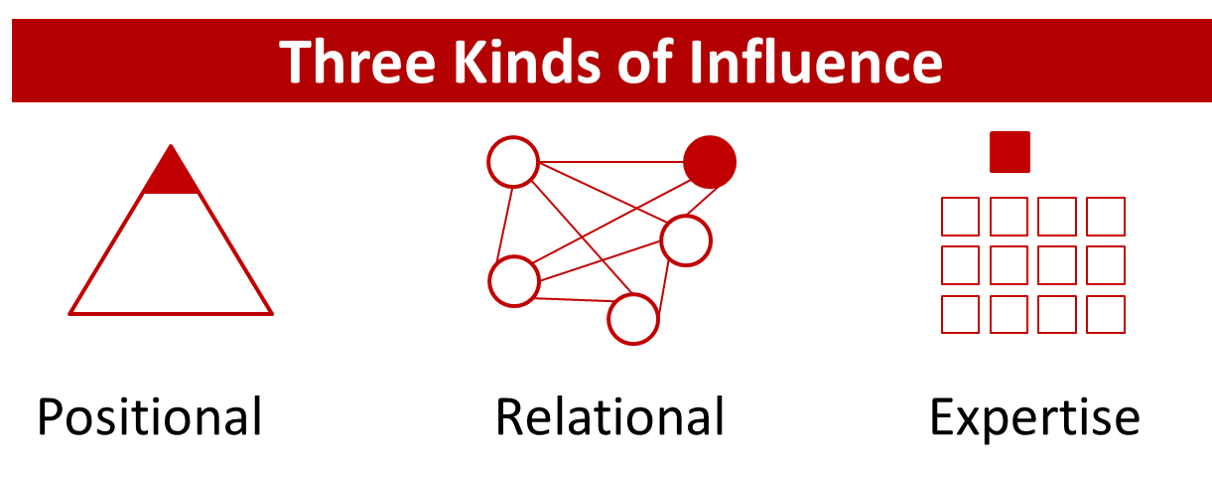Recently, I was reminded that there are three types of influence in the workplace. You might not have all three, but you better have some. . . Positional, Relational, Expertise.
I first heard this on a manager-tools.com podcast, but please let me know if you heard of it somewhere else too. It’s a simple way to think through the problem, but perhaps the most elegant. This applies to each of us professionally, and also to the client project.

Positional Power
This is straight-forward. It is tops-down power. This power comes from the title, budget, headcount and the role that you hold. If it were a math formula it would look like this: COO > VP > Director > Mgr > Analyst.
Positional power does work, but it is like a hammer – blunt, short-term and tiresome. It is like telling your child to do something, and when asked “why”, you respond by saying “Because I am your father, and I said so.” It works, but not really the best parenting.
Relational Power
This is the primary currency in large organizations. People work together, help each other out, team-up for success, forgive mistakes, and generally stick together in the organization. People are inter-related. History is shared. In Influence (affiliate link), Robert Cialdini writes about reciprocity and other ways that people persuade each other. Simply put, we are social creatures and relationships matter.
Expertise Power
This is where the individual shines. This is where education, experience and real thinking come together to create expertise. The MBA would direct you to something called the resource-based view (RBV), which states that really competitive advantage comes from things that are: 1) rare, 2) valuable, 3) difficult to imitate. This is also true for people.
Another way to look at it is how Malcolm Gladwell argues in Outliers (affiliate link) at real expertise takes 10,000 hours of practice. This is based on fascinating research published in HBR called Making of an Expert. As they state, “Consistently and overwhelmingly, the evidence shows that experts are always made, not born.”
How do consultants accumulate influence?
Whether we know it or not, the consulting process is designed to help you accumulate influence at the client site. These are the three keys to getting leverage and being effective.
1. Kick-off meeting. (Positional)
It is customary to have a kick-off meeting where the executive sponsor formally introduces the consultants to her staff, thereby, “loaning” the consultants some of her authority. This allows the consultants to do work and create change. It’s like being a substitute teacher, it is a privilege and borrowed power.
2. Project plan. (Positional)
Consultants like to stay on the project plan. This serves many practical purposes such as organizing activities and scoping the work, but it also has a more subtle effect of giving control to the rhythm of the project. The due dates create momentum and pressure to finish the work. It’s like being the air traffic controller; you are not flying the planes, but have a lot of say on how the airport runs.
3. Best practices. (Expertise)
Consultants bring some objectivity because they benefit from working at multiple competitors, suppliers and customers. Clients like to have that “outside-in” perspective and know where they stand relatively in performance. “What is best practice?” is a common question from executives. Best practices, maturity models, benchmarks, and survey results are all examples of expertise power.
4. Data. (Expertise)
Many clients actually don’t know where they stand. They don’t know if they are running a 5 minute or a 12 minute mile. They have a “sense” (which is usually right), but are hard-pressed to show the data. Consultants love data for many reasons; it gives the consultants credibility and conviction.
5. Being on-site. (Relational)
Generally, consultants don’t have a lot of relational equity. They might know the “buyer” of the services, but often meet the stakeholders at the kick-off meeting. So, it is critically important to get to know the working-level stakeholders as soon as possible. Collaboration is a two-way street. Build rapport; be professional, friendly, and helpful. Yes, there is some tacit understanding that consultants can help (or sometimes hurt) career prospects.
In my mind, one of the main reasons that consultants are often at the client site Monday-Thursday is for relational reasons. The travel is a beast, but it is an effective way to work with the clients, get to know each other, share meals, and build relationships. The ex-CMO of Deloitte wrote a best-seller on building relationships called Never Eat Alone (affiliate link). Guess what the main point of the book is. . . . . never eat alone.
Caveat
All of this power and influence is temporary, borrowed, and sometimes fragile. The patriarch of McKinsey, Marvin Bower, demanded that his consultants have the highest level of professionalism, integrity, and candor. Agreed.
Related Posts:
